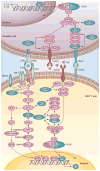Genetics and epigenetics of rheumatoid arthritis
- PMID: 23381558
- PMCID: PMC3694322
- DOI: 10.1038/nrrheum.2012.237
Genetics and epigenetics of rheumatoid arthritis
Abstract
Investigators have made key advances in rheumatoid arthritis (RA) genetics in the past 10 years. Although genetic studies have had limited influence on clinical practice and drug discovery, they are currently generating testable hypotheses to explain disease pathogenesis. Firstly, we review here the major advances in identifying RA genetic susceptibility markers both within and outside of the MHC. Understanding how genetic variants translate into pathogenic mechanisms and ultimately into phenotypes remains a mystery for most of the polymorphisms that confer susceptibility to RA, but functional data are emerging. Interplay between environmental and genetic factors is poorly understood and in need of further investigation. Secondly, we review current knowledge of the role of epigenetics in RA susceptibility. Differences in the epigenome could represent one of the ways in which environmental exposures translate into phenotypic outcomes. The best understood epigenetic phenomena include post-translational histone modifications and DNA methylation events, both of which have critical roles in gene regulation. Epigenetic studies in RA represent a new area of research with the potential to answer unsolved questions.
Conflict of interest statement
The authors declare no competing interests.
Figures




References
-
- Arend WP, Firestein GS. Pre-rheumatoid arthritis: predisposition and transition to clinical synovitis. Nat Rev Rheumatol. 2012;8:573–586. - PubMed
-
- del Junco D, Luthra HS, Annegers JF, Worthington JW, Kurland LT. The familial aggregation of rheumatoid arthritis and its relationship to the HLA-DR4 association. Am J Epidemiol. 1984;119:813–829. - PubMed
-
- Hemminki K, Li X, Sundquist J, Sundquist K. Familial associations of rheumatoid arthritis with autoimmune diseases and related conditions. Arthritis Rheum. 2009;60:661–668. - PubMed
Publication types
MeSH terms
Substances
Grants and funding
LinkOut - more resources
Full Text Sources
Other Literature Sources
Medical
Research Materials
Miscellaneous

